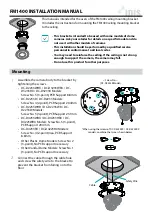
Applications Guide
134
Modline 5
You may wish to read the IRCON publication “Spectrum Reprint SR100 - Product Temperature
Solutions — Temperature Errors Caused by Changes in Emissivity.
8.4.2
Using Emissivity Thermocouple Test
If your material is not listed in the table, or if you want to verify the emissivity value being used, you
can test the emissivity of a target sample in the following lab setup.
1. Embed a thermocouple (30 or 36 gauge wire recommended) just under the surface to be viewed
and heat the target to the desired temperature range. Allow the temperature indication from the
thermocouple to stabilize.
2. Aim the thermometer sensor at the surface of the target sample (close to where the thermocouple
is installed). Observe the temperature indication and adjust the Emissivity value setting so that
this
temperature indication matches the thermocouple reading. The value of the setting is the
target emissivity.
8.4.3
Setting the Emissivity
The Emissivity may be set at the Sensor Rear Panel using the HEAD Menu
EMIS function
or with the
RS-485 EM Command
. An indirect method of setting the Emissivity is to use the
MATCH function or
RS-485 MT Command. MATCH
allows inputting a temperature value known to be the true target
temperature. The Sensor then automatically adjusts the Emissivity so that the temperature display
indicates the same temperature. Instructions for setup are found in Section 5
manual.
A third way to adjust the Emissivity is to send a
scaled input
of 4 to 20 mAdc via the Orange and
Orange/White twisted wire pair of the Sensor’s interconnecting cable. The Modline 5 senses an input
and overrides any other setting of Emissivity or Match. Wiring and scaling information is in Section 4
8.4.4
Using Relative Readings
True temperature readings are not always necessary. Relative temperature readings may suffice in
applications where temperature variations, rather than precise temperature values, are of interest. It is
not necessary to know the target's emissivity for relative temperatures. Meaningful relative
temperatures can be obtained if (a) the Emissivity value setting is kept constant and (b) the target objects
to be viewed are of similar form and composition. For relative readings, we suggest an Emissivity
setting of 1.000.
8.4.5
Practical Limits on Emissivity
While all MODLINE 5 instruments are capable of emissivity settings of 0.100 to 1.000 it is not always
advisable to use the lower emissivity settings. Potential temperature measurement errors due to
background reflections are aggravated by a combination of decreasing target emissivity and decreasing
target temperature. Temperature indications may become "noisy" due to the higher amplification at low
emissivity settings.
For Series 56 and 5G Sensors it is recommended that the Emissivity setting be limited to 0.3 to 1.0 for
the first 55
C (100
F) for all temperature ranges.
The more times reflected radiation “bounces” on a surface, the less reflective the target. This is because
the surface absorbs more of the radiation at each “bounce”, leaving less and less radiation to be reflected
Содержание Modline 5
Страница 2: ......
Страница 4: ......
Страница 156: ...Notices 154 Rev L6 Feb 2017 Modline 5 9 Notices ...
















































